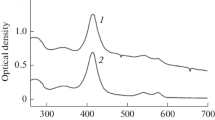Summary
A routine Feulgen procedure for quantitative cytophotometric absorption measurements of DNA at the integrating microdensitometer should be established, which is less alterable by minor deviations in temperature, acid concentration and in duration of hydrolysis than is the 60° C standard treatment. Feulgen hydrolysis curves of alcohol-, formalin- and methanol-formalin-glacialacidicacid-fixed fowl erythrocytes have been examined after hydrolysis in 5 N, 4 N and 2 N HCl at 28° C, as well as in 1 N HCl at 60° C. Fixation in 70% isopropylalcohol and hydrolysis in 5 N HCl for 20 minutes or in 4 N HCl for 45 minutes proved to be particularly useful. Fixation in a mixture of 85% methanol, 10% formalin and 5% glacialacidicacid gave good results, too, but hydrolysis time had to be chosen considerably longer for maximum staining (105 minutes in 4 N HCl). Formalin fixation proved not to be suitable because of a considerable shrinkage of the nuclei resulting in extinctions well above 0.75.
Identical hydrolysis curves have been obtained for di-, tetra- and octoploid liver cell nuclei from alcohol-fixed liver smears. The relative dye contents (AE-values) of these nuclei were in the ratio 1∶2∶4 at all hydrolysis times examined.
Zusammenfassung
Es wurde eine für Routinezwecke geeignete Feulgenreaktion für die cytophotometrische DNS-Bestimmung ausgearbeitet, die gegen geringe Schwankungen der Temperatur, der Säurekonzentration und der Zeitdauer der HCl-Hydrolyse weniger empfindlich ist als die 60°-Standardhydrolyse. Dazu wurden die Feulgen-Hydrolysekurven von alkohol-, formalin- und methanol-formalin-eisessigfixierten Hühnererythrocyten nach Behandlung mit 5 N, 4 N und 2 N HCl bei 28° C, bzw. mit 1 N HCl bei 60° C geprüft und miteinander verglichen. Als besonders brauchbar erwies sich die Fixierung mit 70%igem Isopropylalkohol (20 min Hydrolyse in 5 N HCl oder 45 min in 4 N HCl) und die MethanolFormalin-Eisessig-Fixierung (105 min Hydrolyse in 4 N HCl). Reine Formalinfixierung erwies sich als ungeeignet, da eine starke Kernschrumpfung mit Extinktionen größer als 0,75 beobachtet wurden.
An alkoholfixierten Leberzellausstrichen wurde ein gleichartiger Verlauf der Hydrolysekurven von di-, tetra- und oktoploiden Leberzellkernen festgestellt. Die relativen Farbstoffmengen (AE-Werte) dieser Kerne verhielten sich bei allen geprüften Hydrolysezeiten wie 1∶2∶4.
Similar content being viewed by others
Literatur
Bauer, H.: Die Feulgensche Nuklealreaktion in ihrer Anwendung auf zytologische Untersuchungen. Z. Zellforsch. 15, 225–247 (1932).
Davies, H. G., M. H. F. Wilkins, and R. G. H. B. Boddy: Cell crushing: A technique for greatly reducing errors in microspectrophotometry. Exp. Cell Res. 6, 550–553 (1954).
Decosse, J. J., and N. Aiello: Feulgen hydrolysis: Effect of acid and temperature. J. Histochem. Cytochem. 14, 601–604 (1966).
Deeley, E. M.: An integrating microdensitometer for biological cells. J. sci. Instrum. 32, 263–267 (1955).
Feulgen, R., u. H. Rosenbeck: Mikroskopisch-chemischer Nachweis einer Nukleinsäure vom Typus der Thymonukleinsäure und die darauf beruhende elektive Färbung von Zellkernen in miroskopischen Präparaten. Hoppe Seylers Z. physiol. Chem. 135, 203–248 (1924).
Fossati-Tallard, J.: Etude microfluorométrique de la synthése des acides désoxyroboncléiques dans le cycle mitotique. Z. wiss. Mikr. 68, 1–21 (1967).
Graumann, W.: Zur Standardisierung des Schiffschen Reagenz. Z. wiss. Mikr. 61, 225–226 (1953).
Itikawa, O., and Y. Ogura: The Feulgen reaction after hydrolysis at room temperature. Stahl Technol. 29, 13–15 (1954).
Jordanov, J.: On the transition of deoxyribonucleic acid to apurinic acid and the loss of the latter from tissues during Feulgen reaction hydrolysis. Acta histochem. (Jena) 15, 135–152 (1963).
Kasten, F. H., V. Burton, and P. Glover: Fluorescent Schiff-type reagents for cytochemical detection of polyaldehyde moieties in sections and smears. Nature (Lond.) 184, 1797–1798 (1959).
Naora, H.: Schwarzschild-Villiger-Effekt. Handbuch der Histochemie, Bd. I/1, S. 207–210. Stuttgart: Fischer 1958.
Ornstein, L., and A. W. Pollister: Schwarzschild-Villiger-effect in microspectrophotometry. Science 116, 203–204 (1952).
Sandritter, W., K. Bosselmann, L. Rakow u. K. Jobst: Untersuchungen zur Feulgenreaktion: Die Langzeithydrolyse bei verschiedenen Zelltypen. Biochim. biophys. Acta. (Amst.) 91, 645–647 (1964).
—, K. Jobst, L. Rakow u. K. Bosselmann: Zur Kinetik der Feulgenreaktion bei verlängerter Hydrolysezeit. Histochemie 4, 420–437 (1965).
Author information
Authors and Affiliations
Rights and permissions
About this article
Cite this article
Böhm, N. Einfluß der Fixierung und der Säurekonzentration auf die Feulgen-Hydrolyse bei 28° C. Histochemie 14, 201–211 (1968). https://doi.org/10.1007/BF00306341
Received:
Issue Date:
DOI: https://doi.org/10.1007/BF00306341



